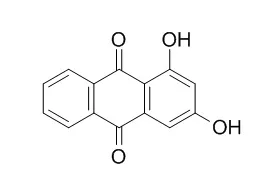| In vitro: |
| Front Pharmacol. 2016 Sep 13;7:308. | | In vitro Antiviral Activity of Rubia cordifolia Aerial Part Extract against Rotavirus.[Pubmed: 27679574] | The root of Rubia cordifolia has been used traditionally as a hemostatic agent, while the aerial part of the plant consisting of leaf and stem is known to exhibit anti-diarrheal properties and has been widely used as a remedy in many parts of China. As rotavirus is one of the most commonly associated diarrhea-causing pathogen, this study aims to investigate the anti-rotaviral effect of R. cordifolia aerial part (RCAP).
METHODS AND RESULTS:
The cytotoxicity of RCAP toward MA-104 cells was evaluated using the WST-8 assay. Colloidal gold method and real time polymerase chain reaction (qPCR) assay were used to confirm the findings of the antiviral assay. Then, 4',6-diamidino-2-phenylindole (DAPI) staining method was subsequently used to investigate the mode of death among the cells. And the representative components of aqueous extract were isolated and identified. It was shown that both the viability of MA-104 cells and the viral load were reduced with increasing concentration of the extract. DAPI staining showed that virus-induced apoptosis was the cause of the low cell viability and viral load, an effect which was accelerated with incubation in the aqueous herbal extract. The major compounds postulated to exhibit this activity were isolated from the aqueous herbal extract and identified to be compounds Xanthopurpurin and Vanillic Acid.
CONCLUSIONS:
This study showed that RCAP extract effectively inhibited rotavirus multiplication by promoting virus-induced apoptosis in MA-104 cells. | | J Nat Prod. 1994 Feb;57(2):313-6. | | Antiplatelet constituents of formosan Rubia akane.[Pubmed: 8176404] | A known steroid, in addition to triterpenoids, anthraquinones, naphthalenes and a new anthraquinone glycoside, Xanthopurpurin 3-O-beta-D-glucoside, were isolated from the roots of Rubia akane grown in Taiwan.
METHODS AND RESULTS:
Mollugin, a naphthohydroquinone, showed strong inhibition of arachidonic acid (AA)-induced and collagen-induced platelet aggregation. In contrast, 2-methyl-1,3,6-trihydroxyl-9,10-anthraquinone, Xanthopurpurin 3-O-beta-D-glucoside, and Xanthopurpurin showed mainly strong inhibition of collagen-induced platelet aggregation. |
|






 Cell. 2018 Jan 11;172(1-2):249-261.e12. doi: 10.1016/j.cell.2017.12.019.IF=36.216(2019)
Cell. 2018 Jan 11;172(1-2):249-261.e12. doi: 10.1016/j.cell.2017.12.019.IF=36.216(2019) Cell Metab. 2020 Mar 3;31(3):534-548.e5. doi: 10.1016/j.cmet.2020.01.002.IF=22.415(2019)
Cell Metab. 2020 Mar 3;31(3):534-548.e5. doi: 10.1016/j.cmet.2020.01.002.IF=22.415(2019) Mol Cell. 2017 Nov 16;68(4):673-685.e6. doi: 10.1016/j.molcel.2017.10.022.IF=14.548(2019)
Mol Cell. 2017 Nov 16;68(4):673-685.e6. doi: 10.1016/j.molcel.2017.10.022.IF=14.548(2019)